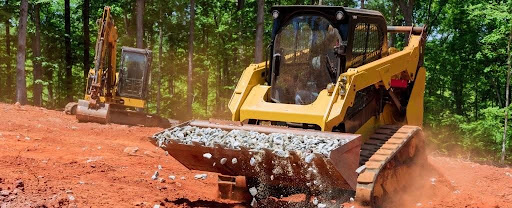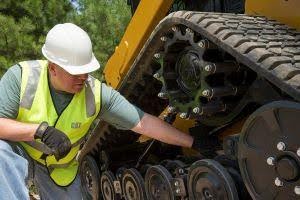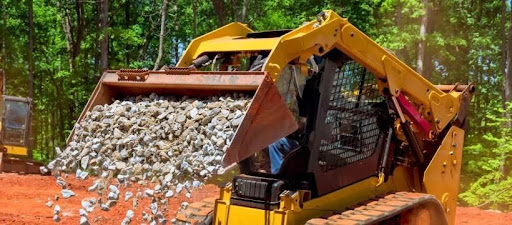
The world of compact construction equipment is advancing rapidly, and one of the biggest beneficiaries of that innovation is the skid-steer loader. Long known for its versatility and maneuverability, the modern skid steer has evolved well beyond its original design. Today’s machines integrate new advancements in automation, electrification, hydraulics, undercarriage systems, and telematics — reshaping what contractors can expect from these compact powerhouses.
Among all these innovations, one area that has made particularly impressive strides is the development of rubber tracks. These systems are transforming how skid steers handle traction, stability, and ground impact, making them more adaptable than ever to demanding jobsite conditions.
1. Smarter Skid Steers: Automation and Telematics
Modern skid steers are no longer purely mechanical. With telematics and automation, operators and fleet managers now have access to insights that boost efficiency and reduce downtime.
Telematics systems track machine health, location, and performance in real time. They can alert operators when maintenance is due or when a potential failure is detected, allowing issues to be resolved before they result in costly downtime.
Smart attachment recognition is another key innovation. When an attachment — like a grapple, trencher, or auger — is connected, the machine automatically recognizes it and adjusts hydraulic flow and control patterns. This ensures optimal performance without requiring the operator to fine-tune settings manually.
Grade-control assistance is also becoming common, offering semi-automated precision during leveling and grading tasks. These systems reduce human error and cut the time needed to achieve perfect site contours.
The result of these combined technologies is higher productivity, reduced fatigue for operators, and greater consistency across job sites — especially for newer operators who may not have years of seat time.
2. Electrification: The Quiet Revolution
As construction sites move toward greener, more sustainable operations, electric skid steers are gaining attention. Several manufacturers have begun releasing battery-powered or hybrid models that deliver full hydraulic performance with zero emissions and minimal noise.
Electric skid steers offer several key benefits:
Lower emissions and noise levels – ideal for indoor work, residential areas, or environmentally sensitive locations.
Reduced operating costs – fewer moving parts mean less maintenance and no need for fuel.
Instant torque delivery – electric motors provide immediate power response, improving precision and control.
The biggest challenge remains battery life and charging time, but ongoing advancements in lithium-ion technology and charging infrastructure are closing that gap quickly. For many contractors, the lower long-term operating costs and quieter performance already make electric skid steers a worthwhile investment.
3. Undercarriage Innovation: The Rise of Rubber Tracks
While skid steers were originally designed with tires, the development of advanced rubber track systems has completely changed how these machines perform in the field. Rubber tracks are now a key factor in improving traction, stability, and surface protection.
3.1 What Rubber Tracks Do
Rubber tracks distribute a skid steer’s weight over a much larger surface area than traditional tires, significantly reducing ground pressure. This means:
Better traction on soft, muddy, or uneven terrain
Less ground disturbance on finished surfaces or turf
Improved flotation over sand, snow, or loose soil
For operators working in landscaping, agriculture, or site preparation, these advantages are critical. Rubber tracks allow work to continue in wet or unstable conditions that would bog down a wheeled skid steer.
3.2 Advances in Rubber Track Technology
Recent designs have focused on durability and ride quality. Reinforced rubber compounds and embedded steel cords now help prevent stretching and tearing while maintaining flexibility. Updated tread patterns optimize self-cleaning, preventing mud buildup that can lead to slippage or premature wear.
Manufacturers have also improved the suspension and roller systems beneath the tracks. Enhanced torsion axles and oscillating rollers allow the undercarriage to flex and adapt to uneven terrain, giving operators a smoother ride and keeping attachments more stable during work.
3.3 Benefits in the Field
Traction and stability: Rubber tracks maintain constant contact with the ground, delivering consistent traction and balance even on slopes or soft soil.
Reduced ground damage: Tracks distribute machine weight evenly, minimizing ruts and soil compaction — particularly important for landscapers and contractors working on delicate lawns or job sites requiring minimal ground disturbance.
Operator comfort: Improved undercarriage design reduces vibration and jolting, keeping the operator comfortable and productive for longer periods.
Year-round performance: Tracks perform reliably in mud, snow, or sand, giving contractors flexibility in nearly any weather or surface condition.
3.4 Practical Considerations
While the advantages are substantial, rubber tracks do come with specific care requirements. They must be properly tensioned and regularly inspected for debris buildup or wear on rollers and sprockets. Additionally, while they excel on soft ground, prolonged use on hard asphalt or concrete can accelerate wear. Many modern track systems are now designed to better withstand mixed-surface operation, making them more versatile than ever.
4. Convertible Undercarriages and Modular Mobility
A growing trend in the skid-steer market is convertibility — systems that allow owners to switch between wheels and tracks depending on jobsite needs. This modular approach offers contractors unmatched flexibility.
On hard surfaces, wheels may still be preferable due to lower wear and faster travel speeds. But when the job shifts to soft or wet ground, converting to rubber tracks allows the same machine to maintain performance without sinking or slipping.
This flexibility gives contractors the best of both worlds — the efficiency of tires and the traction of tracks — without needing two separate machines.
5. Hydraulic and Attachment Innovations
Beyond the undercarriage, hydraulics have also advanced dramatically. Modern skid steers now come with multiple hydraulic flow modes — standard, high-flow, and even “super-flow” systems — allowing operators to use more demanding attachments like cold planers, mulchers, and hydraulic hammers.
Improved quick-coupler systems make attachment swaps faster and safer, while digital controls allow precise adjustment of hydraulic output to match the specific tool in use. Combined with smart-attachment recognition, these systems let a skid steer adapt instantly to new tasks, eliminating guesswork and boosting jobsite productivity.
6. Operator Comfort and Safety Upgrades
Today’s skid-steer cabs are unrecognizable compared to older generations. Innovations in ergonomics, visibility, and control systems are helping operators work longer with less fatigue.
Some of the most noticeable upgrades include:
Enhanced visibility: Larger windows, backup cameras, and low-profile arms improve sightlines around the machine.
Digital control displays: Touchscreens provide real-time monitoring of hydraulic flow, attachment settings, and maintenance alerts.
Suspension seats and smoother tracks: Combined with better undercarriage systems, these improvements reduce vibration and jarring on rough terrain.
Safety systems: Features like automatic parking brakes, slope sensors, and rollover protection are now standard on many models.
A comfortable, confident operator is a productive one — and manufacturers are investing heavily to make sure modern skid steers meet that standard.
7. Future Outlook for Skid-Steer Technology
The future of skid steers is being shaped by the same forces driving the broader construction industry: automation, connectivity, and sustainability. Here are a few trends to watch:
Electric and hybrid expansion: Expect longer runtimes, faster charging, and lower total ownership costs as battery technology improves.
Smart jobsite integration: Skid steers equipped with telematics and connectivity will work seamlessly with other machines and management software, allowing centralized control of entire fleets.
Semi-autonomous operation: Automation will continue to progress, with skid steers capable of performing repetitive tasks — such as grading or material transport — with minimal operator input.
Enhanced undercarriage systems: Rubber track materials will continue to evolve, with new compounds offering longer wear life, improved puncture resistance, and quieter operation.
Focus on ground protection and sustainability: As more projects emphasize environmental responsibility, machines that minimize soil compaction and surface damage — like those with rubber tracks — will be increasingly preferred.
8. Why Rubber Tracks Are Central to the Future of Skid Steers
Skid Steer Tracks represent one of the most practical and impactful upgrades in the skid-steer world. They improve machine performance, reduce downtime, and open up new jobsite possibilities that weren’t feasible with tires alone.
For contractors, the decision to invest in rubber-track systems often comes down to a few key benefits:
Increased uptime – fewer delays caused by soft or muddy conditions.
Better traction and control – crucial for lifting, grading, or operating on slopes.
Lower ground impact – protecting finished surfaces and reducing rework costs.
Expanded versatility – one machine can now handle a wider range of environments.
When paired with today’s smart hydraulics, telematics, and comfort systems, rubber-tracked skid steers are setting new standards for efficiency and adaptability.
9. Conclusion
The modern skid steer has evolved from a simple compact loader into a high-tech, multi-functional work platform. With advances in automation, telematics, hydraulics, and especially rubber track technology, these machines are capable of handling tougher jobs with greater precision and less environmental impact.
For businesses that depend on reliability and performance in changing ground conditions, upgrading to a skid steer equipped with advanced rubber tracks is a smart investment. They deliver superior traction, stability, and versatility — allowing contractors to stay productive year-round, no matter what the terrain throws their way.
As the industry continues to innovate, one thing is certain: the future of construction will rely heavily on smarter, cleaner, and more capable skid steers — and rubber tracks will be at the heart of that evolution.






